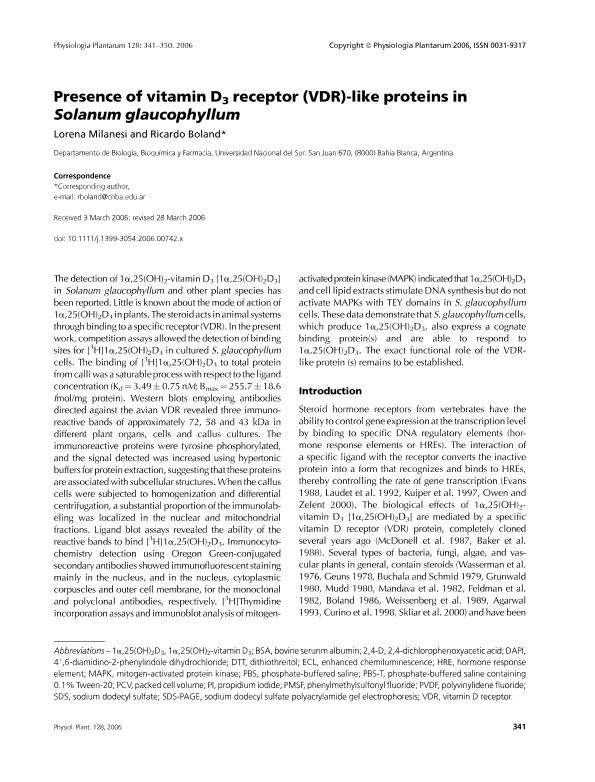Artículo
Presence of vitamin D3 receptor (VDR)-like proteins in solanum glaucophyllum
Fecha de publicación:
26/07/2006
Editorial:
Wiley Blackwell Publishing, Inc
Revista:
Physiologia Plantarum
ISSN:
0031-9317
e-ISSN:
1399-3054
Idioma:
Inglés
Tipo de recurso:
Artículo publicado
Clasificación temática:
Resumen
The detection of 1α,25(OH)2‐vitamin D3 [1α,25(OH)2D3] in Solanum glaucophyllum and other plant species has been reported. Little is known about the mode of action of 1α,25(OH)2D3 in plants. The steroid acts in animal systems through binding to a specific receptor (VDR). In the present work, competition assays allowed the detection of binding sites for [3H]1α,25(OH)2D3 in cultured S. glaucophyllum cells. The binding of [3H]1α,25(OH)2D3 to total protein from calli was a saturable process with respect to the ligand concentration (Kd= 3.49 ± 0.75 nM; Bmax= 255.7 ± 18.6 fmol/mg protein). Western blots employing antibodies directed against the avian VDR revealed three immunoreactive bands of approximately 72, 58 and 43 kDa in different plant organs, cells and callus cultures. The immunoreactive proteins were tyrosine phosphorylated, and the signal detected was increased using hypertonic buffers for protein extraction, suggesting that these proteins are associated with subcellular structures. When the callus cells were subjected to homogenization and differential centrifugation, a substantial proportion of the immunolabeling was localized in the nuclear and mitochondrial fractions. Ligand blot assays revealed the ability of the reactive bands to bind [3H]1α,25(OH)2D3. Immunocytochemistry detection using Oregon Green‐conjugated secondary antibodies showed immunofluorescent staining mainly in the nucleus, and in the nucleus, cytoplasmic corpuscles and outer cell membrane, for the monoclonal and polyclonal antibodies, respectively. [3H]Thymidine incorporation assays and immunoblot analysis of mitogen‐activated protein kinase (MAPK) indicated that 1α,25(OH)2D3 and cell lipid extracts stimulate DNA synthesis but do not activate MAPKs with TEY domains in S. glaucophyllum cells. These data demonstrate that S. glaucophyllum cells, which produce 1α,25(OH)2D3, also express a cognate binding protein(s) and are able to respond to 1α,25(OH)2D3. The exact functional role of the VDR‐like protein (s) remains to be established.
Archivos asociados
Licencia
Identificadores
Colecciones
Articulos(CCT - BAHIA BLANCA)
Articulos de CTRO.CIENTIFICO TECNOL.CONICET - BAHIA BLANCA
Articulos de CTRO.CIENTIFICO TECNOL.CONICET - BAHIA BLANCA
Citación
Milanesi, Lorena Magdalena; Boland, Ricardo Leopoldo; Presence of vitamin D3 receptor (VDR)-like proteins in solanum glaucophyllum; Wiley Blackwell Publishing, Inc; Physiologia Plantarum; 128; 2; 26-7-2006; 341-350
Compartir
Altmétricas




